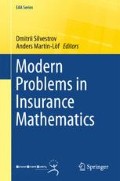Abstract
Insurance claims are often modelled by a standard Poisson model with fixed effects. With such a model, no individual adjustments are made to account for unobserved heterogeneity between policyholders. A Poisson model with random effects makes it possible to detect policyholders with a high or low individual risk. The premium can then be adjusted accordingly. Others have applied such models without much focus on the model’s prediction performance. As the usefulness of an insurance claims model typically is measured by its ability to predict future claims, we have chosen to focus on this aspect of the model. We model insurance claims with a Poisson random effects model and compare its performance with the standard Poisson fixed effects model. We show that the random effects model both fits the data better and gives better predictions for future claims for high risk policy holders than the standard model.
Access this chapter
Tax calculation will be finalised at checkout
Purchases are for personal use only
References
Agresti, A.: Categorical Data Analysis, 2nd edn. Wiley-Interscience, Hoboken (2000)
Antonio, K., Valdez, E.A.: Statistical concepts of a priori and a posteriori risk classification in insurance. AStA Adv. Stat. Anal. 96, 187–224 (2012)
Bates, D., Maechler, M., Bolker, B.: lme4: Linear mixed-effects models using S4 classes. R package version 0.999375-42 (2011)
Boucher, J.-P., Denuit, M.: Fixed versus random effects in Poisson regression models for claim counts: A case study with motor insurance. Astin Bulletin 36(1), 285–301 (2006)
Boucher, J.-P., Denuit, M.: Duration dependence models for claim counts. Deutsche Gesellschaft für Versicherungsmathematik (Ger. Actuar. Bull.) 28(1), 29–45 (2007)
Boucher, J.-P., Denuit, M., Guillen, M.: Models of insurance claim counts with time dependence based on generalization of Poisson and negative binomial distribuitions. Variance 2(1), 135–162 (2008)
Boucher, J.-P., Denuit, M., Guillen, M.: Number of accidents or number of claims? An approach with zero-inflated poisson models for panel data. J. Risk Insur. 76(4), 821–845 (2009)
Boucher, J.-P., Guillén, M.: A survey on models for panel count data with applications to insurance. Revista de la Real Academia de Ciencias Exactas, Fisicas y Naturales 103(2), 277–295 (2009)
Broström, G., Holmberg, H.: glmmML: Generalized linear models with clustering. R package version 0.81-8 (2011)
Fawcett, T.: An introduction to Roc analysis. Pattern Recogn. Lett. 19, 861–874 (2006)
Jong, P.D., Heller, G.Z.: Generalized Linear Models for Insurance Data, ch. 5.5, Cambridge University Press, Cambridge (2008)
R Core Team: R: A Language and Environment for Statistical Computing. R Foundation for Statistical Computing. Vienna, Austria (2012). ISBN 3-900051-07-0. http://www.R-project.org
Rönnegård, L., Shen, X., Alam, M.: The hglm package. R package version 1.2 (2011)
Tomberlin, T.J.: Predicting accident frequencies for drivers classified by two factors. J. Am. Stat. Assoc. 83(402), 309–321 (1988)
Yau, K.W., Yip, K.C.H., Yuen, H.K.: Modelling repeated insurance claim frequency data using the generalized linear mixed model. J. Appl. Stat. 30(8), 857–865 (2003). doi:10.1080/0266476032000075949
Zhang, H., Lu, N., Feng, C., Thurston, S.W., Xia, Y., Zhu, L., Tu, X.M.: On fitting generalized mixed-effects models for binary responses using different statistical packages. Stat. Med. 30(20), 2562–2572 (2011)
Acknowledgments
This work was financed by the centre Statistics for innovation (sfi\(^2\)). The authors thank Gjensidige for kindly providing the data and Lars Holden for valuable suggestions.
Author information
Authors and Affiliations
Corresponding author
Editor information
Editors and Affiliations
Appendix
Appendix
We will prove the relations in Eq. 11.9 between the observed data and the fitted values from the mixed effects model. By Eq. 11.7 the loglikelihood becomes
Now \(\lambda _{\textit{it}}^{\text{ RE }} =\mathrm{{exp}}\left\{ \beta _0^{\text{ RE }}+{\varvec{x}}_{\textit{it}}^\textit{T} \, {\beta }^{\text{ RE }}\right\} \) and \(\Lambda _i^{\text{ RE }}=\sum _{t=1}^{t_i}e_{\textit{it}}\lambda _{\textit{it}}^{\text{ RE }}\). Using this and Eq. 11.5, we find that score functions for the \(\beta \)’s take the form
and
The maximum likelihood estimates are obtained by setting the score functions equal to zero. From this and Eq. 11.8 the relations in Eq. 11.9 follow.
Rights and permissions
Copyright information
© 2014 Springer International Publishing Switzerland
About this chapter
Cite this chapter
Günther, CC., Tvete, I.F., Aas, K., Hagen, J.A., Kvifte, L., Borgan, Ø. (2014). Predicting Future Claims Among High Risk Policyholders Using Random Effects. In: Silvestrov, D., Martin-Löf, A. (eds) Modern Problems in Insurance Mathematics. EAA Series. Springer, Cham. https://doi.org/10.1007/978-3-319-06653-0_11
Download citation
DOI: https://doi.org/10.1007/978-3-319-06653-0_11
Published:
Publisher Name: Springer, Cham
Print ISBN: 978-3-319-06652-3
Online ISBN: 978-3-319-06653-0
eBook Packages: Mathematics and StatisticsMathematics and Statistics (R0)

